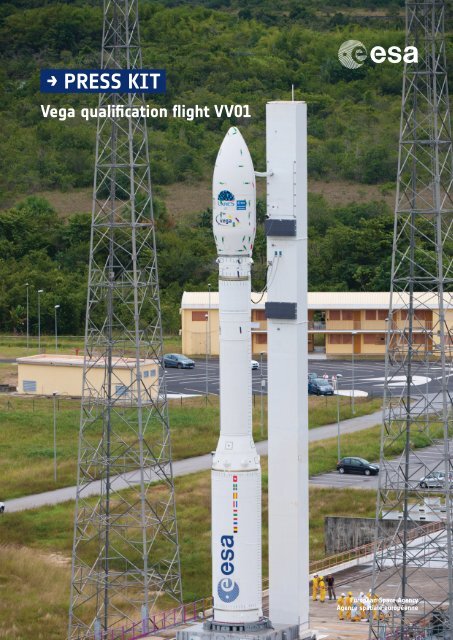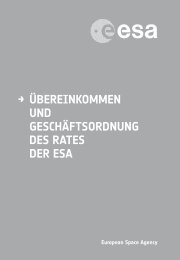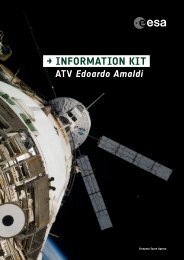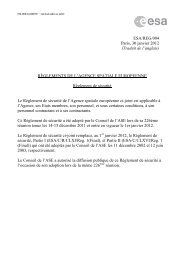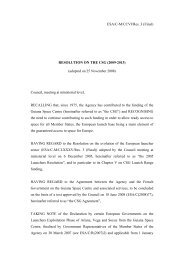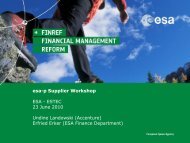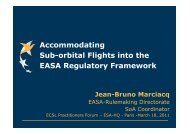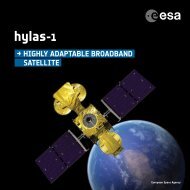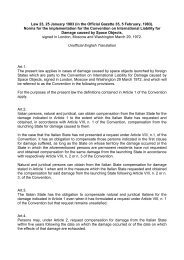Vega press kit - ESA
Vega press kit - ESA
Vega press kit - ESA
You also want an ePaper? Increase the reach of your titles
YUMPU automatically turns print PDFs into web optimized ePapers that Google loves.
→ PRESS KIT<br />
<strong>Vega</strong> qualification flight VV01<br />
European Space Agency<br />
Agence spatiale européenne
PRESS KIT<br />
<strong>Vega</strong> qualification flight VV01<br />
<strong>ESA</strong> inaugurates its new small launch vehicle...................................................................................................... 3<br />
1 The <strong>Vega</strong> launch system...................................................................................................................................... 4<br />
1.1 General design of the launch vehicle ................................................................................................... 4<br />
1.2 The P80FW stage and new technologies ............................................................................................ 5<br />
1.3 The Zefiro stages .......................................................................................................................................... 6<br />
1.4 AVUM ................................................................................................................................................................ 6<br />
1.5 The fairing and adapters............................................................................................................................ 7<br />
1.6 The launch facility ........................................................................................................................................ 8<br />
2 The VV01 mission................................................................................................................................................... 9<br />
2.1 Purpose of the qualification flight ......................................................................................................... 9<br />
2.2 The payloads ................................................................................................................................................10<br />
2.3 Timeline of the launch campaign ........................................................................................................12<br />
2.4 Timeline and flight profile of the mission.........................................................................................13<br />
2.5 The ground telemetry network.............................................................................................................13<br />
3 The <strong>Vega</strong> programme.........................................................................................................................................14<br />
3.1 <strong>Vega</strong> and the small mission launch market segment...................................................................14<br />
3.2 Decision history and funding ................................................................................................................15<br />
3.3 Development timeline .............................................................................................................................16<br />
3.4 The VERTA programme............................................................................................................................17<br />
3.5 The partners and their roles ...................................................................................................................18<br />
<strong>ESA</strong> Media Relations Office<br />
Communication Department<br />
Tel: +33 1 53 69 72 99<br />
Fax: +33 1 53 69 76 90<br />
Email: media@esa.int<br />
2
<strong>ESA</strong> INAUGURATES ITS NEW SMALL LAUNCH VEHICLE<br />
The European Space Agency (<strong>ESA</strong>) is about to conduct the qualification flight of a brand new launch<br />
vehicle for the third time in its history. After Ariane 1 in 1979, Ariane 5 in 1996, 2012 is the year of <strong>Vega</strong>.<br />
<strong>Vega</strong> is designed to complement the family of European launchers already available from French Guiana<br />
with the Ariane 5 heavy-lift launch system and the Soyuz medium-class launcher introduced last October.<br />
<strong>Vega</strong> is a three-stage solid-propellant vehicle with a liquid-propellant manoeuvrable injection module<br />
sized primarily to loft payloads of up to 1500 kg into polar low-Earth orbits at an altitude of 700 km. Its<br />
main objective is to provide Europe with a safe, reliable, competitive and efficient capacity for scientific<br />
and Earth observation payloads.<br />
<strong>Vega</strong> will accommodate a wide range of missions – from 300 kg to 2500 kg – into a wide variety of orbits,<br />
from equatorial to Sun-synchronous. It can also carry single or multiple payloads depending on mission<br />
requirements.<br />
This maiden launch, designated VV01, marks the completion of nine years of development by <strong>ESA</strong> and its<br />
industrial partners, with the support of the Italian and French space agencies, ASI and CNES. Seven <strong>ESA</strong><br />
member states have contributed to the programme: Belgium, France, Italy, the Netherlands, Spain,<br />
Sweden and Switzerland.<br />
The launch is scheduled for 10:00 GMT (11:00 CET; 07:00 local time) on 13 February from the <strong>Vega</strong> Launch<br />
Site (ZLV: Zone de Lancement <strong>Vega</strong>) at the Guiana Space Centre, Europe’s Spaceport in Kourou, French<br />
Guiana. The launch window will last for 120 minutes.<br />
The payload includes two Italian satellites – ASI’s LARES Laser Relativity Satellite and the University of<br />
Bologne’s ALMASat-1 – and seven CubeSat picosatellites provided by European universities: e-St@r (Italy),<br />
Goliat (Romania), MaSat-1 (Hungary), PW-Sat (Poland), Robusta (France), UniCubeSat GG (Italy) and<br />
Xatcobeo (Spain).<br />
<strong>Vega</strong>’s AVUM Attitude and Vernier Upper Module will reach a circular orbit at an altitude of 1450 km and<br />
an inclination of 69.5° to the equator in order to release LARES. Then, it will manoeuvre to lower the<br />
perigee to 350 km before deploying the other payloads.<br />
The mission will qualify the overall <strong>Vega</strong> system, including the vehicle itself, its launch infrastructure and<br />
the operational procedures from the launch campaign up to the payload separation and disposal of<br />
AVUM.<br />
Following this qualification flight, <strong>Vega</strong> operations will be handed over to Arianespace, which will also be<br />
in charge of selling <strong>Vega</strong> on the international launch market. <strong>ESA</strong> will be an early customer of<br />
Arianespace’s new service through a commitment for five launches under the VERTA <strong>Vega</strong> Research and<br />
Technology Accompaniment programme. An initial rate of two launches per year is planned following the<br />
qualification flight.<br />
3
1 THE VEGA LAUNCH SYSTEM<br />
The <strong>Vega</strong> Launch System consists of two main elements, developed together for maximum efficiency:<br />
the Launch Vehicle, including all stages and the Payload Assembly Composite, and the ground segment<br />
to store, integrate and check the vehicle before flight.<br />
Under the prime contractorship of ELV SpA (a joint venture of ASI and Avio), some 1000 people from more<br />
than 40 European industrial companies have worked on the <strong>Vega</strong> vehicle development.<br />
1.1 General design of the launch vehicle<br />
<strong>Vega</strong> is a single-body vehicle composed of three solid-propellant stages for the boost phase:<br />
4<br />
– P80FW first stage<br />
– Zefiro-Z23 second stage<br />
– Zefiro-Z9A third stage<br />
The AVUM fourth stage provides mission versatility and accurate payload injection onto orbit.<br />
The 2.6 m-diameter payload fairing accommodates single or multiple payloads.<br />
Total mass at lift off is 136.7 tonnes; height is 30.1 m; the maximum diameter is 3 m.<br />
<strong>Vega</strong>: P80 first stage, Zefiro-23 second stage, Zefiro-9 third stage, AVUM restartable fourth stage and<br />
upper composite.
Launch performance<br />
The reference performance requirement for <strong>Vega</strong> is to inject 1500 kg into a circular 700 km-altitude orbit<br />
inclined at 90° to the equator, with an injection accuracy of 5 km in altitude and 0.05° in inclination.<br />
The wide range of launch azimuths available from Europe’s spaceport in Kourou, combined with the<br />
flexibility provided by AVUM, will enable <strong>Vega</strong> to deliver a wide range of payloads into different orbits,<br />
from 2500 kg to a circular near-equatorial orbit at 200 km, to 2000 kg towards the International Space<br />
Station or about 1300 kg into a 800 km-high Sun-synchronous orbit.<br />
1.2 The P80FW stage and new technologies<br />
The first stage of <strong>Vega</strong> is based on a large monolithic motor with a load of 88 365 kg of HTPB solid<br />
propellant. The motor delivers 2261 kN of thrust at sea level and burns for 114.3 seconds before being<br />
jettisoned at an altitude of 61 km.<br />
The stage features two major new technologies in order to reduce the vehicle’s mass:<br />
5<br />
– A carbon-epoxy filament-wound motor casing, the largest in the world for a monolithic motor;<br />
– Electromechanical actuators for thrust vectoring, a world’s first for a motor of this size.<br />
Both technologies will be demonstrated and qualified on <strong>Vega</strong> in preparation for future launcher<br />
developments within <strong>ESA</strong>’s Next-Generation Launcher (NGL) initiative.<br />
The P80FW shares a 3 m diameter with Ariane 5’s EAP solid boosters; its 11.2 m overall length is similar to<br />
one of EAP’s largest segments. The same Ariane 5 facilities and equipment at the Guiana Propellant Plant,<br />
next to the spaceport, are used for the P80FW propellant loading and transport. The stage’s nozzle is also<br />
an evolution from that of the Ariane 5 boosters.<br />
Industrial team<br />
APP (Netherlands) Igniter<br />
Avio (Italy) Stage integration and test, loaded motor case<br />
Europropulsion (France/Italy) P80FW motor<br />
Regulus (France/Italy) Propellant loading<br />
Sabca (Belgium) Thrust vector control and stage skirt<br />
SPS (France) Nozzle
1.3 The Zefiro stages<br />
<strong>Vega</strong>’s second and third stages are based on Zefiro solid-propellant motors developed by Avio from its<br />
earlier Zefiro-Z16 ground-qualified motor. Both motors are 1.9 m in diameter with a carbon-epoxy<br />
filament-wound motor casing, low-density EPDM insulation and a flexible joint nozzle with<br />
electromechanical actuators for thrust vector control.<br />
The 8.39 m-long Zefiro-Z23 is loaded with 23 906 kg of HTPB 1912 solid propellant and delivers 1196 kN<br />
of thrust at sea level. It burns for 86.7 seconds.<br />
The 4.12 m-long Zefiro-Z9A is loaded with 10 115 kg of HTPB 1912 solid propellant and delivers a<br />
maximum thrust of 313 kN in vacuum. Although it is <strong>Vega</strong>’s smallest solid-propellant motor, it has the<br />
longest burn time: 128.6 seconds. The Zefiro-Z9A also features the highest mass fraction for solid motors<br />
in this category.<br />
The Zefiro stages are produced by Avio in its facilities in Colleferro, near Rome, Italy. They are loaded with<br />
solid propellant before their shipment to the spaceport.<br />
Industrial team<br />
APP (Netherlands) Igniters<br />
Avio (Italy) Stages production, integration and test<br />
Dutch Space (Netherlands) Interstage 1/2<br />
Rheinmetall Italia (Italy) Interstage 2/3<br />
Sabca (Belgium) Thrust vector control<br />
1.4 AVUM<br />
The Attitude and Vernier Upper Module has a bipropellant propulsion system for orbital injection, and a<br />
monopropellant propulsion system for controlling the vehicle’s roll and the attitude.<br />
AVUM’s primary mission begins at the end of the solid-propulsion phase, when it starts manoeuvring to<br />
reach the targeted deployment orbit with high accuracy. AVUM is designed to deliver different payloads<br />
into different orbits and to perform fine satellite pointing before separation. At the end of the mission, it<br />
is disposed of safely to limit orbital debris.<br />
AVUM carries 550 kg of propellant (UDMH/NTO) in four tanks and is powered by a restartable<br />
2.45 kN RD-869 engine. It incorporates two clusters of three monopropellant thrusters for roll and attitude<br />
control, and accommodates the <strong>Vega</strong> avionics module, which provides flight control and mission<br />
management, telemetry, flight termination, power supply and distribution.<br />
6
1.5 The fairing and adapters<br />
The 20 cu-m, 2.6 m-diameter composite fairing, made of 7.18 m-long half shells, protects the payload<br />
during the ascent through the atmosphere. The payload is mated to the launcher through a<br />
937 mm-diameter adapter. Special adapters for multiple payload arrangements are under development.<br />
Industrial team<br />
Avio (Italy) AVUM integration and test<br />
Moog/Sabca Thrust vector control<br />
EADS Astrium CRISA (Spain) AVUM avionics multifunctional unit<br />
EADS Astrium Space Propulsion (Germany) Roll attitude control system<br />
EADS Astrium ST (France) Flight software<br />
EADS CASA (Spain) AVUM structure and skirt, payload<br />
adapters<br />
KB Yuzhnoye (Ukraine) RD-869 engine and propulsion system<br />
Ruag Space (Switzerland) Fairing<br />
SAAB (Sweden) Onboard computer<br />
SAFT (France) AVUM batteries<br />
Selex Galileo (Italy) AVUM safety avionic unit<br />
Thales (France) AVUM avionics, inertial reference system<br />
Zodiac Data Systems (France) AVUM telemetry avionics unit<br />
7
1.6 The launch facility<br />
Like Ariane 5 and Soyuz, <strong>Vega</strong> is operated from the Guiana Space Centre, Europe’s Spaceport in Kourou,<br />
French Guiana. <strong>Vega</strong> will benefit from the best launch infrastructure in the world, with a maximum extra<br />
velocity provided by Earth’s spin at 5°N latitude for equatorial orbits, a wide range of accessible launch<br />
azimuths over the Atlantic Ocean to reach all orbital inclinations (from equatorial to Sun-synchronous),<br />
and state-of-the-art payload processing facilities.<br />
The <strong>Vega</strong> launch pad (ZLV: Zone de Lancement <strong>Vega</strong>) was built on the old Ariane 1 pad (ELA-1),<br />
decommissioned in 1989. It is located some 1 km southwest from Ariane 5’s ELA-3. The rebuilding work,<br />
led by prime contractor Vitrociset of Italy, started at the end of 2004. The concrete pad was modified to<br />
accommodate <strong>Vega</strong> and the new 50 m-tall Mobile Gantry (MG), weighing some 1000 tonnes, as well as a<br />
32 m-high umbilical mast. Four 60 m-tall towers protect the pad from lightning strikes.<br />
The vehicle’s three solid stages and bipropellant module are stacked on the pad. The payload composite<br />
is mated on top of the vehicle some seven days before launch.<br />
While on the pad, <strong>Vega</strong> and its payload are kept in a controlled environment. The MG is rolled back on its<br />
80 m-long rail track only a few hours before launch.<br />
The ZLV is designed to accommodate a launch rate of four missions per year.<br />
The <strong>Vega</strong> Launch Control Centre (CDL) is in the same building that already houses the Ariane 5 CDL,<br />
1.3 km from the ZLV.<br />
Mission control is provided from the same Jupiter Building that already supports Ariane and Soyuz<br />
launches, 15 km from the pads.<br />
8
2 THE VV01 MISSION<br />
2.1 Purpose of the qualification flight<br />
As the first flight of a new launch system, the VV01 mission is a qualification flight, aimed at<br />
demonstrating the nominal behaviour and performance of all of the elements of the launch system<br />
during the preparation phase of the launcher up to the flight and the separation of the payloads.<br />
The qualification flight is the final step of an incremental qualification process that started with the<br />
development and qualification of various components, subsystems, stages and functions of the vehicle<br />
and of the ground segment, and ended with the verification of the interfaces between the vehicle, the<br />
ground segment and the launch base infrastructure, finally to pronounce the readiness for the first flight.<br />
An im<strong>press</strong>ive number of tests were performed progressively, from component to system level.<br />
The qualification flight is the final confirmation of the design of the launch system and the final validation<br />
of the system models used for the mission definition in flight conditions.<br />
The main qualification objectives for the launch vehicle include the liftoff kinematics with respect to the<br />
pad interfaces, the ignition, performance, flight control, thrust vector control and separation of all three<br />
solid stages, the fairing separation, AVUM performance and restart capability, payload release<br />
manoeuvres and accuracy and finally AVUM passivation at the end of the mission with a deorbiting<br />
manoeuvre to comply with debris mitigation policies.<br />
To monitor all these events during the flight, the VV01 launcher carries extra sets of sensors and three<br />
telemetry systems to download data in real time to the ground. These data will be processed after the<br />
flight to identify possible discrepancies. As a demonstrator for new technologies, the first stage has its<br />
own set of sensors with a dedicated telemetry system.<br />
In order to prepare for future operational flights, the LARES payload platform carries a set of sensors,<br />
including accelerometers, acoustic sensors and cameras to monitor the payload environment during the<br />
flight.<br />
The vehicle is not the only system to be qualified with this mission. All ground systems and launch<br />
procedures will be qualified simultaneously. This includes payload processing and integration, launcher<br />
acceptance via the readiness control checks with a simulated countdown and mission sequence, final<br />
prelaunch readiness checks via the automatic sequences during the final countdown, readiness check of<br />
the launch base and of all support means needed during the flight (weather forecast, telemetry downlink<br />
stations, tracking stations, flight termination).<br />
9
2.2 The payloads<br />
Although the maiden flight was foreseen as a single-payload mission, the collaboration between <strong>ESA</strong> and<br />
ASI allowed it to be upgraded into a multiple-payload mission. The primary payload for this qualification<br />
flight is the LARES satellite of Italy’s space agency, ASI. The secondary mission covers the ALMASat-1<br />
microsatellite from the University of Bologna and seven picosatellites from European universities.<br />
LARES, ALMASat-1 and the seven CubeSats.<br />
LARES (Laser Relativity Satellite) is a science satellite developed by ASI to study the<br />
‘Lense–Thirring effect’ – a consequence of Einstein’s general relativity – explaining precession of bodies’<br />
orbits in the vicinity of large spinning masses such as Earth.<br />
The satellite, built by Carlo Gavazzi Space, is a passive 376 mm-diameter sphere made of tungsten alloy<br />
weighing about 400 kg. It features 92 cube corner retroreflectors for laser ranging from Earth. LARES will<br />
be released into a 1450 km-altitude circular orbit and will complement ASI’s previous Lageos-1 and<br />
Lageos-2 laser geodynamics satellites, launched in 1976 and 1992, respectively.<br />
The avionic in the LARES support structure is also in charge of powering the separation systems for the<br />
other payloads, driven by launch vehicle commands to the LARES avionics.<br />
10
ALMASat-1 (Alma Mater Satellite) is a 12.5 kg technology demonstration microsatellite developed and<br />
built by the University of Bologne. It consists of a 30 cm cube designed as a modular structure that could<br />
be used for various technology demonstrations or Earth observation missions. On this first mission the<br />
main objective will be to test the key performance, such as 3-axis pointing accuracy, of this low-cost<br />
multipurpose bus in preparation for future missions.<br />
To ensure its reentry within 25 years, ALMASat-1 will be deployed into an elliptical orbit with a perigee at<br />
350 km.<br />
Seven picosatellites sharing the same CubeSat design (1 kg, 1 W, 10 cm cubic structure) developed by<br />
universities from <strong>ESA</strong> member or cooperating states were selected within European universities on behalf<br />
of <strong>ESA</strong>’s Education programme. They will be released by three P-PODs (Poly-Picosatellite Orbital<br />
Deployers) mounted on the LARES structure into an elliptical orbit with a 350 km perigee that will ensure<br />
their safe reentry within 12 years. These seven cubesats are:<br />
e-St@r Developed by the Polytechnics Institute of Turin, Italy. It will test an active determination and<br />
control subsystem for 3-axis control as well as a set of commercial components and materials.<br />
Goliat Developed by the University of Bucharest, Romania. It will perform Earth imaging with a 3megapixel<br />
digital camera and conduct measurements of radiation and micrometeoroids in low-Earth<br />
orbit. This is Romania’s first satellite.<br />
MaSat-1 (Magyar Satellite) Developed by the Budapest University of Technology and Economics,<br />
Hungary. It will demonstrate a power conditioning system, a transceiver and an onboard data handling<br />
system. This is Hungary’s first satellite.<br />
PW-Sat-1 Developed by the Warsaw University of Technology, Poland. It will deploy a solar sail as a<br />
deployable drag augmentation device in order to accelerate the removal of picosatellites at the end of<br />
their missions. This is Poland’s first satellite.<br />
Robusta (Radiation On Bipolar for University Satellite Test Application) Developed by the University of<br />
Montpellier, France. It will study the effect of radiation on electronic components based on bipolar<br />
transistors for comparison with its own degradation models.<br />
UniCubeSat GG Developed by the GAUSS astrodynamics group of the University of Rome ‘La Sapienza’,<br />
Italy. It will deploy two booms to demonstrate gravity-gradient stabilisation on a picosatellite. Each boom<br />
will carry a solar panel at its end to generate electrical power.<br />
Xatcobeo Developed by the University of Vigo, Spain. It will test a software-defined reconfigurable radio<br />
and an ionising radiation measurement system. It will also test a solar panel deployment system.<br />
11
2.3 Timeline of the launch campaign<br />
Event Date<br />
Flight Readiness Review #1 13–14 Oct 2011<br />
Arrival of <strong>Vega</strong> VV01 stages and LARES in<br />
Kourou<br />
24 Oct 2011<br />
Delivery of LARES to S1B payload processing<br />
facility<br />
26 Oct 2011<br />
Start of launch campaign 7 Nov 2011<br />
P80FW transferred to the ZLV and installed on<br />
the pad<br />
7 Nov 2011<br />
Delivery of P-PODS and CubeSats in Kourou late Nov 2011<br />
Zefiro-Z23 stage stacked 2 Dec 2011<br />
Flight Readiness Review #2 7 Dec 2011<br />
Zefiro-Z9A stage stacked 9 Dec 2011<br />
P-PODs integrated on LARES adapter 12–14 Dec 2011<br />
AVUM integrated 16 Dec 2011<br />
Final checkout 13 Jan 2012<br />
Start of combined operations 19 Jan 2012<br />
Upper composite mated 21 Jan 2012<br />
First gantry rollback 26 Jan 2012<br />
Countdown rehearsal 1 Feb 2012<br />
AVUM propellant loading and <strong>press</strong>urisation 3–6 Feb 2012<br />
Launcher final preparation 12 Feb 2012<br />
Launch day 13 Feb 2012<br />
12
2.4 Timeline and flight profile of the mission<br />
Event Time Altitude Relative Speed<br />
Start of synchronised sequence –3 min 30 s<br />
P80FW ignition T0 0 km 0 m/s<br />
Liftoff 0.3 s 0 km 0 m/s<br />
Transonic (Mach 1) 30.7 s 4.7 km 332 m/s<br />
Maximum dynamic <strong>press</strong>ure 53 s 13 km 586 m/s<br />
P80FW burnout and separation 1 min 54.8 s 60 km 1.7 km/s<br />
Z23 ignition 1 min 55.6 s 61 km 1.7 km/s<br />
Z23 burnout and separation<br />
Start of coast<br />
3 min 22.3 s 127 km 3.8 km/s<br />
Z9A ignition 3 min 38.5 s 135 km 3.8 km/s<br />
Fairing separation 3 min 43.5 s 138 km 3.9 km/s<br />
Z9A burnout and separation 5 min 47.1 s 182 km 7.7 km/s<br />
AVUM 1st ignition 5 min 54.1 s 185 km 7.7 km/s<br />
AVUM 1st cutoff<br />
Injection into transfer orbit<br />
8 min 45 s 260 km 7.8 km/s<br />
AVUM 2nd ignition 48 min 7.3 s 1447 km 6.6 km/s<br />
AVUM 2nd cutoff<br />
Injection into first target orbit<br />
52 min 10.5 s 1450 km 6.9 km/s<br />
LARES separation 55 min 5.5 s 1450 km 6.9 km/s<br />
AVUM 3rd ignition 1 h 6 min 10.5 s 1457 km 6.9 km/s<br />
AVUM 3rd cutoff<br />
Injection into second target orbit<br />
1 h 10 min 34.3 s 1458 km 6.6 km/s<br />
ALMASat-1 and CubeSats separation 1 h 10 min 35.3 s 1458 km 6.6 km/s<br />
End of mission 1 h 21 min 0.3 s 1344 km 6.7 km/s<br />
2.5 The ground telemetry network<br />
Acronym Telemetry Station Location<br />
KAG Kourou acq. Galliot French Guiana<br />
SNA Station Navalisée Ariane Atlantic Ocean<br />
SMA St Maria Azores Islands, Portugal<br />
SVB Svalbard Svalbard Islands, Norway<br />
JEU Jeju South Korea<br />
APE Perth Australia<br />
MGS McMurdo Antarctica<br />
13
3 THE VEGA PROGRAMME<br />
3.1 <strong>Vega</strong> and the small mission launch market segment<br />
In the late 1990s, with the advent of component miniaturisation and the development of the<br />
‘faster–better–cheaper’ approach to reduce development cost and time, space agencies around the globe<br />
started developing small satellites. Europe joined the trend with a new family of missions such as the<br />
Earth Explorers (four launches since 2005).<br />
In the meantime, commercial communication satellites have continued to grow in size and mass, and led<br />
the Ariane launch system to a range of performance in payload capacity no longer compatible with small<br />
science and Earth observation missions.<br />
In the years following the collapse of the Soviet Union, large quantities of decommissioned ballistic<br />
missiles became available for refurbishment into low-cost small-satellite launchers such as Rockot and<br />
Dnepr. For years, the availability of such affordable vehicles prevented the development of competitive<br />
launch solutions in this market segment, even driving existing US launch systems out of the international<br />
market.<br />
However, the era of refurbishing missiles into launch vehicles is coming to end as the stockpiles are<br />
depleted and the cost of maintaining or refurbishing old missiles into flightworthy hardware is increasing.<br />
To maintain a competitive and independent access to space for this new range of missions – which will<br />
become increasingly strategically critical in the near future with the advent of new satellite series such as<br />
the Sentinels – it became paramount for <strong>ESA</strong> to develop its own small satellite launch system.<br />
The <strong>Vega</strong> launch system is designed to offer a reliable, flexible, regularly available and maintainable<br />
capacity to lift such missions into space. Once qualified, <strong>Vega</strong> will be operated commercially by<br />
Arianespace in the European and the international launch markets, where its competitive advantages will<br />
provide an edge against ageing rival systems.<br />
Moreover, <strong>Vega</strong> is an evolutionary system that could later be adapted to meet evolution in demand.<br />
The first commercial launch contract for <strong>Vega</strong> was signed on 14 December 2011, by <strong>ESA</strong> and Arianespace,<br />
for the launches of two Sentinel satellites and preparation of the suborbital flight of the IXV demonstrator.<br />
14
3.2 Decision history and funding<br />
The <strong>Vega</strong> programme has its roots in Italy’s operations of US-built Scout launchers in cooperation with<br />
NASA from the Italian San Marco platform, anchored off the coast of Kenya from 1967 to 1988.<br />
In 1977, the University of Rome began studying technical options to improve Scout. In the late 1980s,<br />
concepts for a Scout 2, adding Ariane solid strap-on boosters (AAPs) from Ariane 3 to a Scout G1, were<br />
studied with Avio’s ancestor, BPD.<br />
In 1992, as the US Scout production line was closed down, the project continued as a sole Italian venture<br />
under the name San Marco Scout, led by ASI and Avio and based on a new series of Zefiro rocket motors.<br />
It was eventually renamed <strong>Vega</strong> (Vettore Europeo di Generazione Avanzata, or advanced generation<br />
European vehicle) in mid-1993, when <strong>ESA</strong> and its industrial partners began study concepts for various<br />
Ariane 5 complementary launchers.<br />
The first decision towards the Europeanisation of <strong>Vega</strong> was taken by <strong>ESA</strong>’s Council, meeting at Delegate<br />
level in June 1998 in Brussels. The final decision to start development activities was taken by the <strong>ESA</strong><br />
Launchers Programme Board on 27–28 November 2000; the programme officially started on<br />
15 December 2000, when seven states committed to its funding.<br />
Several configurations of the launcher were analysed during the preparation activities that ended up in<br />
February 2003, when the contract for its development and qualification was signed between <strong>ESA</strong> and ELV<br />
SpA. The contract for the development and qualification of the ground segment was signed in 2005<br />
between <strong>ESA</strong> and Vitrociset.<br />
Contributions to <strong>Vega</strong> and P80FW development<br />
Belgium 6.9%<br />
France 25.3%<br />
Italy 58.4%<br />
The Netherlands 3.2%<br />
Spain 4.6%<br />
Sweden 0.6%<br />
Switzerland 1.0%<br />
Total 100%<br />
The <strong>Vega</strong> programme is managed under the responsibility of <strong>ESA</strong>, by an Integrated Programme Team at<br />
<strong>ESA</strong>’s ESRIN centre in Frascati, near Rome. <strong>ESA</strong>, CNES and ASI staff participate in this team, which receives<br />
technical support from <strong>ESA</strong>’s ESTEC technical centre and the Launchers Directorate (DLA) of CNES.<br />
The launcher industry team is led by ELV SpA, a joint venture of Avio (70%) and ASI (30%). The ground<br />
segment industry team is led by Vitrociset.<br />
Within the <strong>Vega</strong> programme, the P80FW development project was led by a joint <strong>ESA</strong>/CNES/ASI team,<br />
now located in Paris, with Avio as prime contractor and programme delegation to Europropulsion.<br />
In total, the development of <strong>Vega</strong> will have cost some €710 million funded through <strong>ESA</strong> contributions,<br />
and about €76 million through direct industrial investment by Avio in the development of the P80FW.<br />
15
3.3 Development timeline<br />
1998<br />
22 Jun Z16 first ground firing test (success)<br />
24 Jun <strong>ESA</strong> council approves the <strong>Vega</strong> programme<br />
1999<br />
17 Jun Z16 second ground firing test (success)<br />
2000<br />
19 Dec <strong>Vega</strong>’s funding is approved<br />
2001<br />
21 Feb ASI and Fiat Avio incorporate ELV<br />
2002<br />
Jun Launcher Preliminary Design Review<br />
2003<br />
25 Feb <strong>ESA</strong> contracts with ELV for launch vehicle development and qualification<br />
2004<br />
20 Oct Start of the ELA1 refurbishment work into ZLV<br />
2005<br />
20 Dec Z9 first ground firing test (success)<br />
2006<br />
23 May Ground Segment System Design Review<br />
26 Jun Z23 first ground firing test (success)<br />
30 Nov P80FW first ground firing test (success)<br />
Dec. Critical Design Review<br />
2007<br />
28 Mar Z9 second ground firing test (nozzle failure)<br />
4 Dec P80FW second ground firing test (success)<br />
Dec Fairing qualification<br />
2008<br />
27 Mar Z23 second ground firing test (success)<br />
23 Oct Z9A first ground firing test (success)<br />
Dec Z23 stage qualification.<br />
2009<br />
28 Apr Z9A second ground firing test (success)<br />
2010<br />
Feb AVUM stage qualification (structure and propulsion).<br />
Apr Payload adapter qualification<br />
25 May Z9A VERTA ground firing test (success)<br />
Jul Kickoff of the Launch System Combined Tests campaign<br />
Nov Z9A stage qualification<br />
2011<br />
11 Feb Completion of the functional mockup launcher integration on pad<br />
Apr Dry run<br />
30 Sep Ground Segment Technical Qualification Review<br />
3–7 Oct Launch System Operational Readiness Review<br />
13–14 Oct Flight readiness review<br />
7 Nov Start of VV01 launch campaign<br />
2012<br />
13 Feb Qualification flight<br />
16
3.4 The VERTA programme<br />
The <strong>Vega</strong> Research, Technology & Accompaniment (VERTA) programme was approved by <strong>ESA</strong>’s Council in<br />
December 2005, during <strong>ESA</strong>’s Ministerial Conference in Berlin. It is a three-fold programme to support and<br />
secure the initial operations of the <strong>Vega</strong> launch system.<br />
First, it includes the procurement of five <strong>Vega</strong> launches for <strong>ESA</strong>, to ensure an initial exploitation phase at a<br />
launch rate of at least two flights per year.<br />
Under the current schedule, these launches are due to carry a set of small science and technology<br />
payloads together with the Proba-V remote sensing satellite in early 2013, the ADM-Aeolus satellite to<br />
probe the atmosphere in late 2013, the LISA Pathfinder science mission demonstrator in 2014 and the<br />
Intermediate eXperimental Vehicle (IXV) reentry demonstrator in early 2014. A payload flight opportunity<br />
remains available for the fifth launch. Production contracts were signed in 2010 for these five launchers.<br />
Secondly, VERTA covers the development of complementary services and hardware, such as a<br />
multiple-payload launch capacity and new payload adapters tailored for <strong>Vega</strong>’s specific markets.<br />
Finally, VERTA provides a framework for component testing in order to mitigate risks for production drifts<br />
and to enable the qualification of new technologies to prevent obsolescence. In this role, VERTA is the<br />
equivalent of Ariane 5’s ARTA-5 Ariane Research, Technology & Accompaniment programme.<br />
As such, VERTA includes ground-firing tests of <strong>Vega</strong>’s solid rocket motors as well as production sampling<br />
and testing on a regular basis. These activities started in 2006 and have contributed, through tests and<br />
additional analysis, to increasing the robustness of the ground qualification of the <strong>Vega</strong> launch system.<br />
VERTA is supported by contributions from the same countries contributing to <strong>Vega</strong>’s development<br />
(Italy, France, Spain, Belgium, the Netherlands, Switzerland and Sweden) with an envelope budget of<br />
€400 million covering the five flights and accompaniment activities to 2014.<br />
Contributions to VERTA<br />
Belgium 5.6%<br />
France 24.1%<br />
Italy 57.8%<br />
The Netherlands 2.5%<br />
Spain 7.7%<br />
Sweden 0.7%<br />
Switzerland 1.6%<br />
Total 100%<br />
17
3.5 The partners and their roles<br />
<strong>ESA</strong><br />
As for all its other programmes, the European Space Agency is responsible for the implementation of the<br />
programme and of its technical and financial management. Its technical supervision is founded on its<br />
30 years of experience. The decisions by <strong>ESA</strong> and the participating states provide the formal base for<br />
<strong>Vega</strong>’s integration into the European space transportation fleet and its long-term access to the<br />
institutional market. <strong>ESA</strong> heads the integrated <strong>Vega</strong> programme team and owns the ZLV facilities.<br />
ASI<br />
Since Italy is providing more than 50% of the overall funding for the <strong>Vega</strong> programme, the Italian space<br />
agency plays a significant management role through the integrated <strong>Vega</strong> programme team at <strong>ESA</strong>’s<br />
ESRIN centre in Frascati, near Rome. It owns 30% of ELV SpA.<br />
CNES<br />
The French space agency, CNES, has led the project team for P80FW development. It also contributes to<br />
the integrated programme team in ESRIN and provides technical support for developing the launcher<br />
and ground segment. CNES has been also highly involved, as test executor, in the combined tests<br />
campaign. CNES teams are also involved in the launch campaign in support of the <strong>Vega</strong> Integrated<br />
Project Team.<br />
Arianespace<br />
As it already does for Ariane and Soyuz, Arianespace holds exclusive rights to market and sell <strong>Vega</strong> launch<br />
services. Once <strong>Vega</strong> is qualified, operating the <strong>Vega</strong> launch system will be under the responsibility of<br />
Arianespace. Arianespace teams have been supporting the development and qualification of the launch<br />
system and are highly involved in the launch campaign.<br />
ELV<br />
The ELV SpA company was incorporated in 2001 to manage <strong>Vega</strong>’s development and production, with<br />
industrial architect responsibility. ELV is responsible for the delivery and integration of <strong>Vega</strong> launchers.<br />
As industrial prime contractor, ELV is in charge of acceptance of the launcher’s components and<br />
integration at the launch site. As launcher’s design authority, it also participates in final preparations and<br />
launch operations.<br />
Avio<br />
As prime contractor for all three solid-propellant stages of <strong>Vega</strong> and integrator of AVUM, Avio is the<br />
primary industrial partner of the <strong>Vega</strong> programme. It also owns 70% of ELV SpA.<br />
Vitrociset<br />
Under contract from <strong>ESA</strong>, Vitrociset is prime contractor for the <strong>Vega</strong> ground segment.<br />
18


